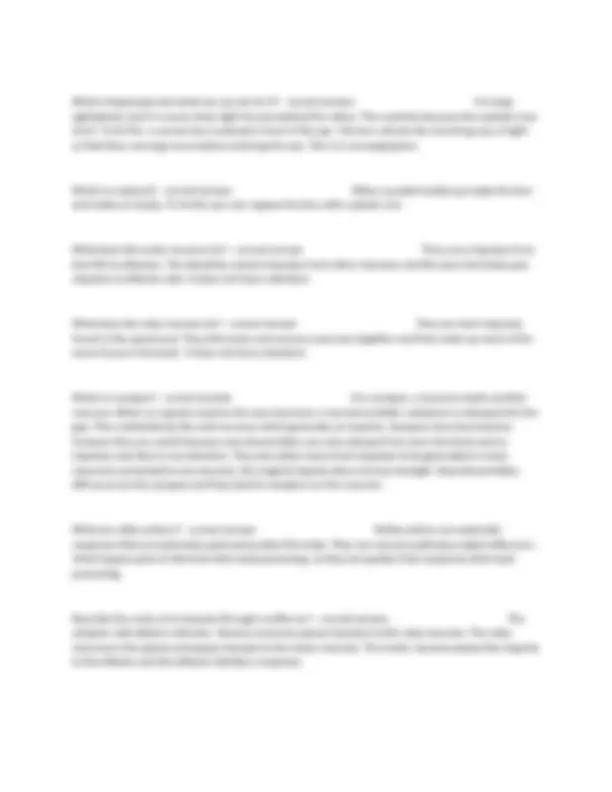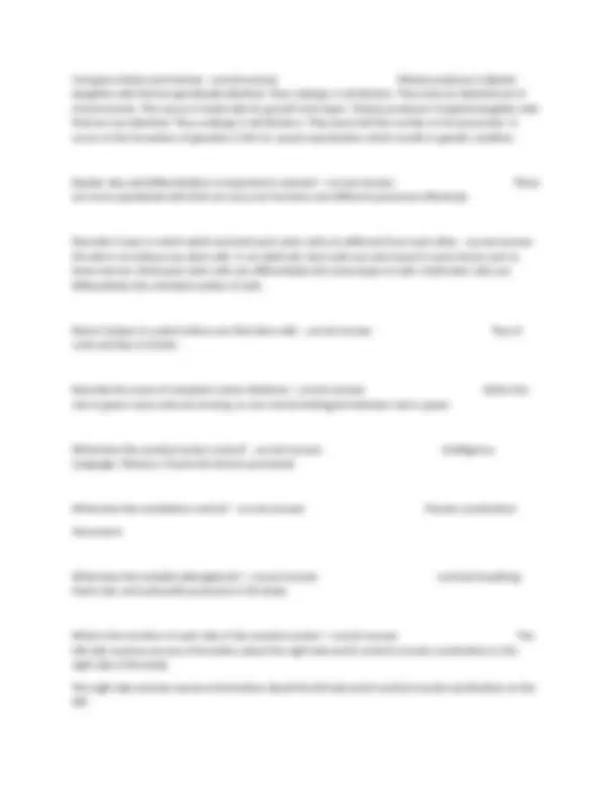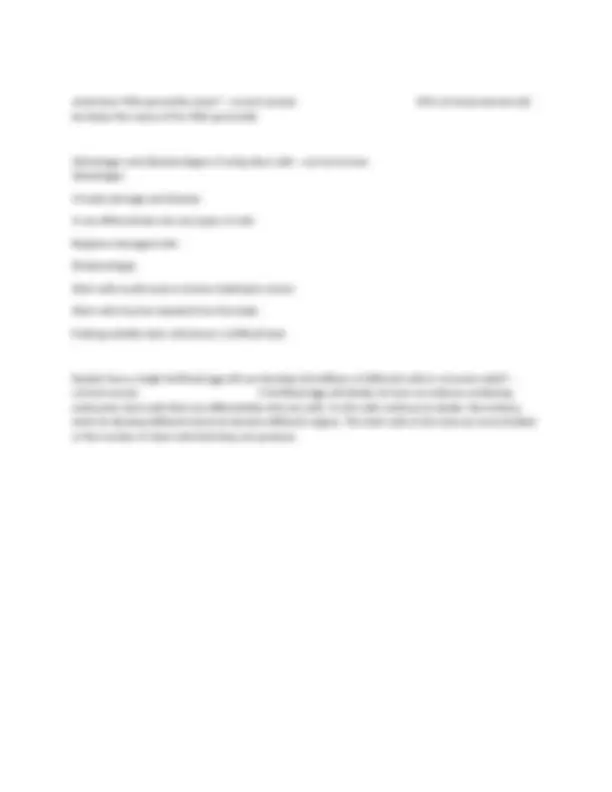





Study with the several resources on Docsity

Earn points by helping other students or get them with a premium plan


Prepare for your exams
Study with the several resources on Docsity

Earn points to download
Earn points by helping other students or get them with a premium plan
Community
Ask the community for help and clear up your study doubts
Discover the best universities in your country according to Docsity users
Free resources
Download our free guides on studying techniques, anxiety management strategies, and thesis advice from Docsity tutors
Edexcel GCSE Biology Cells and control certification review exam
Typology: Exams
1 / 5

This page cannot be seen from the preview
Don't miss anything!




What is a CT scan? - correct answer It shows the shapes of structure in the brain. A x-ray beam moves in a circle around the head. The detector measures the absorption of these xrays. A computer uses this information to build a view of images inside the brain. This is a series of slices. Differences in the shape of the brain can be linked in the differences in which people think and act, suggesting the functions of those parts of the brain. What is a PET scan? - correct answer A PET scan shows brain activity. A patient is injected with radioactive glucose. More active cells take in more glucose than less active ones for respiration. The radioactive atoms cause gamma rays, which the scanner detects. More rays come from active cells. What happens when there is spinal cord damage? - correct answer It reduces the flow of information between the brain and parts of the body. Nerve damage can cause loss of feeling in legs and their use. Damage in the neck and cause quadriplegia (the loss of use of legs and hands). No adult stem cells can differentiate into neurones so they cannot be used for repair damage. How does a brain tumour work and how can it be treated? - correct answer Cancer cells often divide rapidly to form a tumour. A brain tumour may squish some parts of the brain or it maybe stop it from working. Tumours may be cut out or the cells can be killed by radiotherapy or chemotherapy. Chemotherapy may not work due to the blood-brain barrier. This is a natural filter that only allows certain substances to get from the blood to the brain (due to the cells in the capillary walls in the brain fitting closely together). What forms the central nervous system? - correct answer brain and spinal cord, this allows all of the body to communicate using electrical signals called impulses. Nerves make up the rest of the nervous system. What is neurotransmission? - correct answer The transmission (travelling) of impulses What happens in the nervous system when someone picks up a pencil? - correct answer Impulses from receptor cells are transmitted by sensory neurones in the optic nerve to our brain. The
brain processes these impulses and sees the pencil. It sends more impulses to the muscles, the response. Muscles in the hand receive the impulses and make the hand move to pick up the pencil. What is a sensory neurone and how is it specialised? - correct answer It carries impulses from receptor cells towards the CNS. A receptor cell impulse passes into a tiny branch called a dendrite. It is then transmitted through the dendron and axon. A series of axon terminals allow impulses to be transmitted to other neurones. A fatty layer surrounds the dendron and the axon called the myelin sheath, this electrically insulates a neurone from neighbouring neurones, stopping the signal loosing energy. This also makes an impulse jump between the gaps in the myelin, speeding up neurotransmission. What are cones? - correct answer Cones are receptor cells that are sensitive the colour of light. Cones generate impulses in sensory neurones, which leads to the brains through the optic nerve. The information from cones is combined in the brain to produce all the colours. What are rods? - correct answer They detect differences in light intensity, not colour. Rods work well in dim light, but cones work well in bright light. This is why colour vision does not work well in dim light. What does the iris and pupil do? - correct answer The pupil is the dark area in the middle of the eye where light enters. The amount of light that enters is controlled by the iris which can constrict (decrease the diameter) of the pupil or dilate it ( increase the diameter) of the pupil. Bright light can damage receptor cells in the retina What does the cornea and lens do? - correct answer It focuses light rays entering the eye onto a point in the retina to produce a clear image. It bends the light rays to bring them together. The lens then fine-tunes the focusing. What does the ciliary muscles do? - correct answer It makes the lens fatter to focus light from near objects. It makes the lens thinner to focus light from objects with distance. What is Myopia and what can you do for it? - correct answer It is short- sightedness and it is a condition where light focuses in front of the retina instead of on it. A reason for this could be that the eyeball is too long or the cornea is too curved and it bends light more. A concave lens is placed in front of the eye, so that the lens refracts the incoming rays of light, so they diverge more. This is a diverging lens
Compare mitosis and meiosis - correct answer Mitosis produces 2 diploid daughter cells that are genetically identical. They undergo 1 cell division. They have an identical set of chromosomes. This occurs in body cells for growth and repair. Meiosis produces 4 haploid daughter cells that are non-identical. They undergo 2 cell divisions. They have half the number of chromosomes. It occurs in the formation of gametes in the for sexual reproduction which results in genetic variation. Explain why cell differentiation is important in animals? - correct answer There are more specialised cells that can carry out functions and different processes effectively Describe 2 ways in which adult and embryonic stem cells are different from each other - correct answer All cells in an embryo are stem cells. In an adult cell, stem cells are only found in some tissue such as bone marrow. Embryonic stem cells can differentiate into many types of cells. Adult stem cells can differentiate into a limited number of cells. Name 2 places in a plant where you find stem cells - correct answer Tips of roots and tips of shoots Describe the cause of red-green colour blindness - correct answer Either the red or green cones cells are missing, so one cannot distinguish between red or green. What does the cerebral cortex control? - correct answer Intelligence, Language, Memory, Visual and sensory processed What does the cerebellum control? - correct answer Muscle coordination Movement What does the medulla oblongata do? - correct answer controls breathing, heart rate, and automatic processes in the body. What is the function of each side of the cerebral cortex? - correct answer The left side receives sensory information about the right side and it controls muscle coordination in the right side of the body. The right side receives sensory information about the left side and it control muscle coordination on the left.
what does 95th percentile mean? - correct answer 95% of measurement will be below the value of the 95th percentile. Advantages and disadvantages of using stem cells - correct answer Advantages It treats damage and disease It can differentiate into any types of cells Replaces damaged cells Disadvantages Stem cells could cause a tumour leading to cancer Stem cells may be rejected from the body Finding suitable stem cell donors is difficult task Explain how a single fertilised egg cell can develop into billions of different cells in a human adult? - correct answer A fertilised egg cell divides to form an embryo containing embryonic stem cells that can differentiate into any cells. As the cells continue to divide, the embryo, starts to develop different areas to become different organs. The stem cells in the area are more limited in the number of stem cells that they can produce.